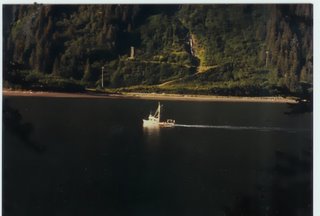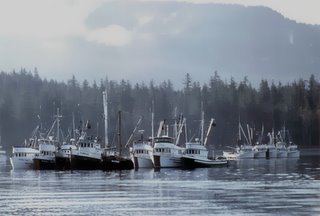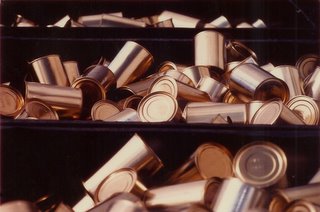
Since we don't have such a critter in this country, I'll have to post a hyperlink to a
European fish waste site. It's a business-to-business site. Which means if you have a bunch of fish waste you don't know what to do with, you look on the site and get a whole list of companies that deal with the type of problem you have.
This kind of treatment will become a thing of the past as soon as fishermen get involved in marketing.
I think, at the moment, we're supposed to be waiting for someone up in Fairbanks to come up with some solutions for using all the fish waste in Alaska. They could keep a web site like this one, at the minimum, so folks would have something to go on. When the magic bullet finally is off the drawing boards, then the site would be rendered moot. But in the meantime, it would be nice if we at least kept up with the Joneses.
You might say that the processors know all about waste by-products already. Well, maybe and maybe not. And what about those small processor start-ups? Oh, I forgot, the goal is to not let anyone else into the processing game, that is, if you buy into the Gulf of Alaska Groundfish Rationalization Plan. And if that's the case, then chalk up vertical integration by fishermen as un-American and just a bad idea. You'd be a lot better off with a moritorium on fisheries politicians that have never lived in a coastal fishing community or been on a boat with a gaff hook in hand or helped pile the seine.
It always comes back to what type of structure works best for all the problems confronting fishermen and communities. And that's an
association. Well, we have the green light by the government to make them happen now, like they have all over the world. Sometimes I wonder why the huge attack on fishermen and small processors, now that there is a light at the end of the tunnel for them. Look at what associations do, they find new markets and develop new products. Here's an example:
"THE Norwegian prawn industry is at risk of disappearing, but product development and establishment of new markets are two strategies that can save the industry, a report from Norwegian Institute of Fisheries and Aquaculture Research, Fiskeriforskning concludes."
The large processors shouldn't be fighting the association concept, there still needs to be processing. And they own the facilities that can make new products happen the easiest. Some fishermen are already finding procesors who will basically buy their fish, process it the way the fishermen want, and sell it back to them. If the processor didn't thermally abuse the fish, or contaminate it, or freeze it too slowly, etc, the fisherman has a great product he can go out into the marketplace with.
Establishing new markets is a very pointed task. It's not scattering brochures from an airplane. It takes a bunch of research by a talented researcher. Then it takes salesmanship by a talented salesman. The researchers are the ones that competed in science fairs as kids. The salesmen, and women, are the ones that set up lemonade stands as kids. It won't work without the born talent.
Product development comes out of the market research. A good test kitchen makes the new products and a bunch of computer geeks fills in the rest. THEN you have something to take to a processor. Just like you take a finished manuscript to a publisher. Of course it depends on how complicated the product, but the point is that the fishermen will have to know the processing game. Or at least someone in their midst will have to.
The associations don't have to feel like they are at the mercy of the large processors, they can start bringing in floaters to do their processing. Eventually the shore plant owners will give up their desire to control the marketing in favor of their own survival. Or they will sell out like Columbia Wards did because it's just "no fun" anymore without the day to day fighting.
Take a look at how fast headed, gutted and frozen pink prices have risen in the last couple of years. Now it's up to over 60 cents a pound. Those are probably going mostly to Chinese buyers for further processing, per my favorite brokers. A well funded group of pink salmon fishermen in Kodiak proved that fishermen can negotiate with the big processors on marketing issues. It's just a matter of not blinking. And if you can work that 62 cents/lb wholesale down to an ex-vessel price by figuring for recovery of fish and eggs, deductions for ice and slime, shipping materials, labor, reasonable overhead and profit margin, then you have a good start.
Sockeye fillets are coming out of Bristol Bay and with the pinbones out. Not from the big processors though. They are, in some cases, backing off from value adding.
I was reading an article in the PI one morning, getting ready to go over to the Pacific Marine Expo., and I thought, how appropriate to what fishermen need to reinvent themselves. It was about a Peter Drucker who was the guru of CEOs, the most influential management thinker of the last century. He was the first to forsee the arrival of "knowledge workers" motivated by personal pride as much as by fear and a paycheck.
Another corollary I want to mention that has to do with getting these product development and marketing innovation associations going comes from a columninst in the same Seattle Post Intelligencer. Daneen Skuhe says that psychologists have a word to describe people who tend to suck up all the responsibility in a room: over-functioning. I see that in some of us that work like mad for nothing, to make things better for a whole lot of others. The presidents of these Regionals are like that. Another is the Canadian writer of the fisheries/politico book "Salmon Wars," Dennis Brown.
On the other hand psychologists also have a word to describe people who take too little responsibility: under-functioning. This describes the fishermen that sit back and support the status quo, slowly warming up in the pot of boiling water like the proverbial frog, and say, "when I see the prices start to rise, I'll think about throwing in with them." People in either pattern tend to get into trouble. The former burn out and flounder and the latter flounder when their leaders flounder.
The trick here for fishermen is to not be afraid of shadows. They are the bravest people I know in a lot of ways, but when it comes to letting go of the apron strings of the cannery, there is a huge disconnect. The people who wrote the Regional Seafood Development Association legislation knew it would be hard for a lot of folks to vote for them and risk the canneries finding them out and cutting them off. That's why only three out of ten need to be brave for the other seven. And the third that vote need to cough up a majority to be for the progam.
The seminar at Pacific Marine Expo., that was basically a concensus building meeting of the Bristol Bay RSDA, was history in the making. I don't know how many people caught that. It got down to brass tacks when one person spoke against the Regional and then everyone else couched their remarks in favor of the program in terms of how narrow minded that guy that spoke against it was.
This post got a long way from products made from waste, but I doubt there will be any impetus to develop new products, even from the basic fish, unless the processor/fishermen relationship changes. Remember processors are called processors because they process fish. If they are allowed to run your life, like the processor in Sand Point that told fishermen they couldn't get home heating oil if they took their fish elsewhere, then I suppose you could call your plant "the Godfather."
This is getting down to brass tacks. So while I'm at it, I'll say it's not only the processors that hold the people of little Alaskan towns captive. When the state ferries started running, people could get on one and go shop at another town where the prices were better. One die hard store mogul met at least one ferry to write down the names of people getting off, for whatever reason. A lot of people use store credit, but this was just laughable for most of them looking to
not get robbed in their home town anymore.













